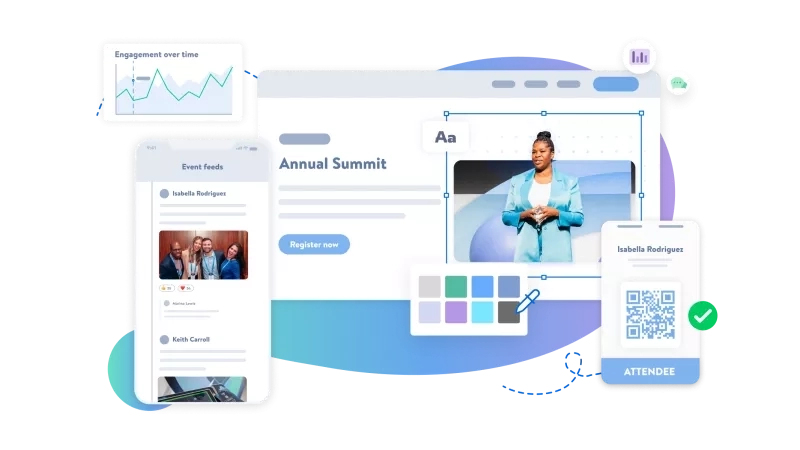It’s no secret that event costs are rising, from general event expenses like F&B and A/V to internet fees and much more. In fact, 65% of planners say the current economic outlook is their primary concern, and most planners are concerned or extremely concerned about rising costs.
So, when the words “event” and “budget cuts” are used together in the same sentence, it’s an acceptable reaction for meetings professionals to wince a bit and start scrambling for ways to deliver the kind of engaging experiences attendees expect while also holding firm to the bottom line.
The truth is, it IS possible to reduce the budget for your function and still deliver great attendee experiences. And we’ve got some practical tips you can use right away. Leverage these tips and tech to save on event costs:
1. Be open-minded
Just because a conference is traditionally held at a certain hotel around a particular date doesn’t mean it’s written in stone. Check out affordable venues easily using a venue sourcing tool, and consider unique venue types you might not have experienced before. Become more flexible, and adjust event dates to reduce costs further. Also, play with the event schedule. You could, for example, start the conference in the afternoon to eliminate breakfast and lunch from your budget.
2. Find your vendors early
As soon as the venue’s booked, immediately search for vendors and suppliers. Reach out to vendors and suppliers early to make sure everything you need will be available for your event dates. Last-minute panic situations can cost extra if vendors have to adjust their schedules to accommodate your needs. Also, arrange a kick-off meeting with all the vendors and suppliers involved so the planning is organized and there’s no duplication of efforts. Host regular follow-up conference calls leading up to the event.
3. Invest and reuse
Purchase stagingthat can be arranged in several different ways and versatile lighting elements to create a unique feel for each event. In addition, produce graphics that can be reused for annual functions. And bonus, reusing is environmentally friendly and can help you with your sustainability initiatives!
4. Save on power and Wi-Fi
Electricity isn’t cheap. Opt for the latest battery-powered lighting and energy-saving audio systems. Work with your hotel, convention center, or A/V provider and ask about ways to save. Also, compare the venue’s Wi-Fi with the price of other providers. There might be more affordable options with better equipment. If the venue has an exclusive provider, ask if that part of the contract can be waived.
5. Go paperless
Mobile apps ‒ particularly those that can be reused for future events ‒ are one way to share event schedules and information while saving on printing costs. Registrations and follow-up surveys should be online to save on mailing costs. And for the bigger items, consider replacing banners and posters with digital signage – which will also help save on last-minute changes should speakers need to be swapped or rooms adjusted.
6. Dynamic access portal
A dynamic access portal helps you identify and eliminate duplicate meetings. It allows you to prevent conflicts with global holidays or industry events. It will also make it easy to identify opportunities to combine meetings and leverage existing hotel contracts.
7. Venue sourcing tech
Venue sourcing tech can potentially save you 8-20%. Several factors make saving that much possible. When it comes to manual efforts, these tools eliminate contacting hotels for pricing and availability, as well as consolidation of proposal information. Instead, it offers the ability to view property data online, search for relevant properties online, and tag relevant vendors as preferred.
It is also an outlet to drive business to preferred vendors by combining meetings to leverage negotiated pricing, see historical rates, and view seasonality. If that isn’t enough, you can also push contract negotiations to SMEs, reduce the risk and cost of bad contract language, and select suppliers aligned with your sustainability strategy. Accomplish it all without a worry – this technology ensures standard contract addendums are included, and you can ask standard risk management questions on every RFP.
8. Venue diagramming tech
Event diagramming tech offers virtual walk-throughs, helps you create diagrams in minutes with flexible templates, and allows you to make updates in seconds. You can also collaborate with team members to make changes and updates. It has the bonus of cutting down on-site visits, thereby limiting travel costs!
9. Event registration
Event registration software can give you potential savings of 2-10% by permitting attendees to self-enter data or preload registrants. It will also help you combine local attendee data with traveler data for a comprehensive duty of care program. So that you are always prepared, this tool keeps corporate safety/first responders updated on local meetings/needs in case of emergency.
10. Onsite solutions
Onsite solutions software helps you seamlessly manage and check in your attendees, and greatly reduce the waste of unused badges. Now you can eliminate manual effort associated with data entry of leads into CRM or upload of data into your CRM. Not only does it make the event easier on you, but it also reduces the risk of lost leads by immediately putting leads into the hands of sales.
Level up your budgeting
Using even just one of these cost-saving tips and technologies will help you cut the budget for your next event. Check out our cost savings calculator to level up your budgeting game even more!





